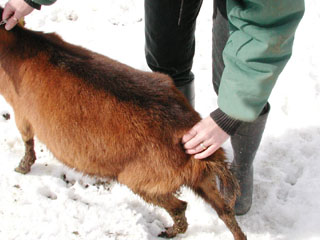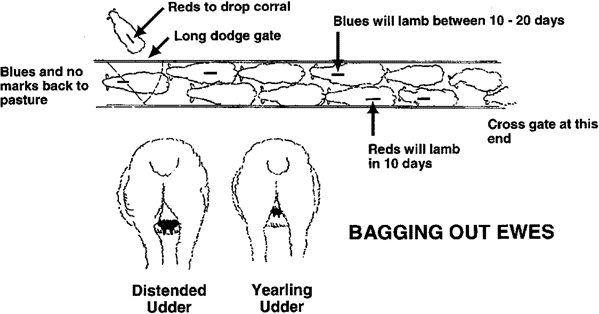
| This picture shows the location of the ligaments that will soften when the mother is close to giving birth. |
Reasons for Separating:
The care and management of ewes and does during the lambing/kidding season can largely determine the profits for the year. The good producer will keep constant vigilance over the flock/herd during this period. Newborns are lost when they are abandoned by their mothers, chilled, and/or not given timely and necessary assistance when birthing difficulties arise. Because of these challenges, the labor requirements on the producer are the greatest at lambing/kidding time. To help ease labor requirements during this time, separation of ewes/does about to give birth is essential.When the flock or herd is large, time and labor may be saved by separating the mothers that are nearest to lambing/kidding from the rest of the flock/herd. The "heavy" ewes/does are often placed in separate smaller groups or "drop bands" a week or two prior to lambing/kidding. This has many advantages. First, the loss of newborns due to birthing difficulties will be reduced because it will be possible to watch the heavy ewes/does much more closely. A good producer checks the drop band frequently and is more likely to discover a "stuck" newborn or a mother in trouble if the numbers are smaller. Second, more of the mothers (the less heavy ones) can be kept on pasture and away from the pens/corrals used for lambing/kidding for a longer period. This is desirable because the mothers continue to get exercise and do not drain more costly hay resources used to feed the heavy animals that are confined. Keeping a ewe/doe confined for more than a 7-10 days before she gives birth can cause paralysis and other difficulties. Finally, the likelihood of a yearling giving birth to her first baby and immediately running off and leaving the newborn will be increased when large bands are not separated into smaller groups. This often occurs when the band is made up of many yearlings mixed with the older animals or with the previous year’s replacements. A problem also occurs with the 12-month old ewe replacements that are kept in association with ewes that are lambing. The ewe replacements are often curious about the fresh lambs and have the tendency to bother and butt them. This can sometimes result in death of the newborn if their mothers are not well acquainted with their lamb and do not stay close to them. These situations can be avoided by separating the flock and with close observation by the producer.
Determining When a Ewe or Doe May Give Birth:
If breeding dates have not been recorded, the next best method to determine when a mother might give birth is by general observation and actually handling her udder. Mothers about to give birth will "sink in" on either side of the rump in front of the hips, the vulva will enlarge, wax will form on the ends of the teats, there will be signs of distention of the udder, and the teats will begin to be tight and show signs of filling. The sacrotuberous ligament and other ligaments near the base of the tail will also soften. Experienced producers can identify an animal that is very near (within 24 hours) to giving birth by simply handling these ligaments. To gain experience, it is often helpful to compare the ligaments of animals that are close to giving birth, to ones that are a few weeks off or that are not pregnant. |
|
Realize that not every animal will experience all of the above signs and that these signs may appear days to weeks before the mother will give birth. Mothers that have produced a baby before, generally have larger udders than a ewe/doe carrying her first baby. Because of this, every udder should be observed and then handled when making the udder examination. This process is termed "bagging-out" or "bagging" the band. The animals about to lamb/kid may be placed in individual jugs or in corrals depending upon the flock/herd size and type of enterprise.
Producers who have used a ram/buck marking system with brands, and then have kept records of lambing/kidding dates can make up their "drop-bands" according to those dates. The ewes/does can be divided into those animals that are near lambing/kidding (<7 days), those that are 7-14 days away, and those that are more than 14 days away. The latter group may be further divided the same way at a later date.
How to Separate (essential for large sheep bands): Various methods of effective separation will be found, varying with the size of the band or flock/herd. In a band of 2,000 females, probably the largest number of animals in a drop bunch will be 300, and most of these should give birth and be replaced by others in 7-10 days. During the heaviest part of the lambing/kidding season, this number might be 500. In smaller flocks/herds, a similar proportion might be separated. Careful selection and some training are required when attempting to identify the 300 heaviest animals to make up the drop band. For example, some animals will show good-sized udders for over a month before they give birth. Others "bag-up" within 10 days of giving birth, while others (especially yearlings) hardly show a bag even when they lamb/kid. Therefore, observation and handling of every udder is necessary.
Marking Ewes/Does: In making the examination and marking large groups of ewes/does for separation into drop bands, a chute with a swinging gate at one end (dodge gate) can be helpful. A washable (solvable) branding paint consisting of two colors is also essential equipment. The chute may be filled and udder examinations made. A good procedure in accomplishing the separation in a large band is outlined below:
Below: Bagging and chalking to separate a drop bunch.

If very few ewes/does are involved, separation will generally consist merely in bringing them to a small corral where they can be looked over and the tight-bagged ewes/does can be caught and slipped into the next corral. To make sure that none are missed, use the following suggestion. Walk backwards into the group. Then as the animals move to the other side of the pen or out through a gate into another pen, the rear quarters and udder can be observed. This will help identify those animals that may have been missed previously.
Handling the Ewes/Does About to Lamb/Kid: There are several different methods for handling ewes and does about to give birth. These methods will vary depending on the environmental conditions and size of the operation. When flocks/herds are large, lambing/kidding on pasture or in the open is generally more practical than to attempt to furnish barns or sheds. Naturally, the weather must be reasonably warm for pasture lambing/kidding. Many successful range sheep operators will confine heavy animals to a corral at night. The "night corral" may be fitted with temporary pens made from panels, where ewes may be confined for a day or so with their lambs. Because it is not always easy to tend the entire lambing corral at night, many lambs will be saved if special attention can be given to just the ewes that are lambing.
Many small goat operations can successfully handle the kidding season by utilizing a small barn or shed that is clean, well bedded with fresh straw, and insulated enough to provide protection from the elements.
Large sheep operations that lamb on pasture may require individual lambing tents to give the ewe and her newborn lamb(s) temporary protection from inclement weather. It also helps to provide lighting. If electricity is not available, gas lanterns may be used. Lights help to keep predatory animals away and the mothers to find and keep better track of their newborn lambs.